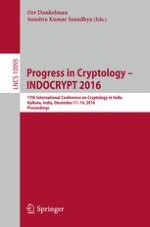2016 | Buch
Progress in Cryptology – INDOCRYPT 2016
17th International Conference on Cryptology in India, Kolkata, India, December 11-14, 2016, Proceedings
herausgegeben von: Orr Dunkelman, Somitra Kumar Sanadhya
Verlag: Springer International Publishing
Buchreihe : Lecture Notes in Computer Science
